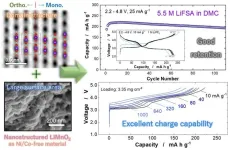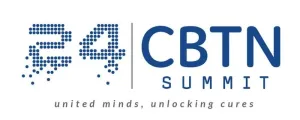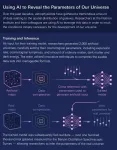(Press-News.org) Lithium-ion (or Li-ion) batteries are heavy hitters when it comes to the world of rechargeable batteries. As electric vehicles become more common in the world, a high-energy, low-cost battery utilizing the abundance of manganese (Mn) can be a sustainable option to become commercially available and utilized in the automobile industry. Currently, batteries used for powering electric vehicles (EVs) are nickel (Ni) and cobalt (Co)-based, which can be expensive and unsustainable for a society with a growing desire for EVs. By switching the positive electrode materials to a lithium/manganese-based material, researchers aim to maintain the high performance of Ni/Co-based materials but with a low-cost, sustainable twist.
Researchers published their results in ACS Central Science on 26th Aug., 2024.
Li-ion batteries are not new players in the field of rechargeable electronics, but there are always ways to innovate and improve already reliable methods. LiMnO2 as an electrode material has been studied in the past but has always been limited by restrictive electrode performance.
“Through the systematic study on different LiMnO2 polymorphs, it is found that the monoclinic layered domain effectively activates structural transition to the spinel-like phase. From this finding, nanostructured LiMnO2 with the monoclinic layered domain structures and high surface area has been directly synthesized by using a simple solid-state reaction,” said Naoaki Yabuuchi, author and researcher of the study.
A monoclinic system refers to the type of group symmetry of a solid crystalline structure. A Li/Mn arrangement with the monoclinic symmetry appears to be key in making LiMnO2 a feasible option for a positive electrode material. Without the structural phase transition the monoclinic domain allows, electrode performance would be limited thanks to the sub-optimal crystalline structure of LiMnO2 and accompanying phase transitions.
After observing and testing the various polymorphs, it was determined the needed structure can be synthesized directly from two components without having to use an intermediary step. The resulting material is competitive with nickel based layered materials and boasts excellent fast-charging abilities, which is indispensable for electric vehicles.
The nanostructured LiMnO2 with the monoclinic layered domain is synthesized by a simple calcination process to yield a product with high-energy density, reaching 820 watt-hours per kilogram (Wh kg-1), compared to about 750 Wh kg-1 for nickel-based layered materials and 500 Wh kg-1 for other low-cost lithium-based materials.
There is also no reported voltage decay using nanostructured LiMnO2, which is common in manganese-based materials. Voltage decay is a phenomenon in which the voltage decreases gradually, over time reducing the performance and responsiveness of an electronic. However, it does not seem to be an observable issue in the case of nanostructured LiMnO2, which is the subject of the study.
Though there are promising results, a practical issue can be observed: the dissolution of manganese. Over time, manganese can dissolve due to many factors, such as phase changes or reacting with acidic solutions. Fortunately, this can be curbed or completely mitigated by the use of a highly concentrated electrolyte solution and a lithium phosphate coating.
Researchers hope their findings contribute to a more sustainable energy source than fossil fuels, especially concerning electric vehicles. The performance of LiMnO2, with its competitive energy density compared to nickel-based materials, demonstrates the potential alternative materials can have to produce environmentally friendly products that are sustainable both in production and as a long-term investment. An ideal future for nanostructured LiMnO2-based electrode materials would involve commercialization and industrial production in the luxury electric vehicle industry.
Yuka Miyaoka, Yuna Oguro, Yosuke Ugata and Naoaki Yabuuchi of the Department of Chemistry and Life Science at Yokohama National University with Yosuke Ugata and Naoaki Yabuuchi also of the Advanced Chemical Energy Research Center at Yokohama National Univeristy, Takahito Sato of the Department of Applied Chemistry at Tokyo Denki University, Sayaka Kondo, Koki Nakano and Masanobu Nakayama of the Frontier Research Institute for Materials Science at Nagoya Institute of Technology, Damian Goonetilleke and Neeraj Sharma of the School of Chemistry at the University of New South Wales, Alexey M. Glushenkov of the Research School of Chemistry at the Australian National University, Satoshi Hiroi and Koji Ohara of the Faculty of Materials for Energy at Shimane University, Koji Takada and Yasuhiro Fujii of the Tosoh Corporation contributed to this research.
JSPS, Grant-in-Aid for Scientific Research, JST, MEXT Program: Data Creation and Utilization-Type Material Research and Development Project, JST Adopting Sustainable Partnerships for Innovative Research Ecosystem (ASPIRE), JST The Green Technologies for Excellence (GteX) Program, the Australian Research Council, the Photon Factory Program Advisory Committee, the Japan Synchrotron Radiation Research Institute (JASRI), the Aichi Synchrotron Radiation center, the Australian Nuclear Science and Technology Organisation (ANSTO) made this research possible.
##
Yokohama National University (YNU or Yokokoku) is a Japanese national university founded in 1949. YNU provides students with a practical education utilizing the wide expertise of its faculty and facilitates engagement with the global community. YNU’s strength in the academic research of practical application sciences leads to high-impact publications and contributes to international scientific research and the global society. For more information, please see: https://www.ynu.ac.jp/english/
END
Li-ion batteries show promise as cheap and sustainable alternative to Ni/Co materials
2024-08-26
ELSE PRESS RELEASES FROM THIS DATE:
The Lundquist Institute announces updates to its Board of Directors
2024-08-26
The Lundquist Institute for Biomedical Innovation at Harbor-UCLA Medical Center (TLI) announced updates to its Board of Directors today. TLI welcomes one new distinguished member and thanks the two outgoing members for their invaluable contributions.
“On behalf of the Board, I am delighted that Dr. Bill Dorfman, a global leader in cosmetic dentistry, has joined the TLI Board. Dr. Dorfman's extensive expertise and commitment to philanthropy make him an invaluable addition to our leadership,” said Mitchel Sayare, PhD, TLI Board ...
Research from UTHealth Houston finds parents who recently experienced intimate partner violence had higher potential for parenting stress and child maltreatment
2024-08-26
Parents who recently experienced intimate partner violence reported more parenting stress and higher potential for child maltreatment, and were less likely to use positive parenting strategies, according to UTHealth Houston research published Aug. 26, 2024, in JAMA Pediatrics.
“Our findings demonstrate the collateral damage of domestic violence — that the negative consequences are not limited to the couple and instead have the potential to affect how they parent, and ultimately the health of their children. We must expend every effort to prevent this public health problem,” said Jeff Temple, PhD, ...
Research spotlight: Key regulators of pd-1 in melanoma cells and the immune system’s response
2024-08-26
How would you summarize your study for a lay audience?
Immune checkpoint inhibitors are cancer fighting drugs that help the immune system do its job of detecting and attacking tumor cells. Programmed Cell Death 1 (PD-1) is a common target for this type of drug—it is a protein that sits on the surface of T cells and helps regulate the immune system’s response to neighboring cells, both normal and cancerous. While most research efforts to date have focused on PD-1’s role in T cells, it is also active in many other kinds of cells—including cancer cells as first demonstrated by the Schatton ...
Lighting the way for quantum innovation
2024-08-26
ALBUQUERQUE, N.M. — Sandia National Laboratories and Arizona State University, two research powerhouses, are collaborating to push the boundaries of quantum technology and transform large-scale optical systems into compact integrated microsystems.
Nils Otterstrom, a Sandia physicist specializing in integrated photonics, is at the forefront of scaling down optical systems to the size of a chip. This innovation offers performance advantages and scalability for an array of applications from advanced computing to secure communications.
“Integrated ...
Spin squeezing for all
2024-08-26
Nothing in science can be achieved or understood without measurement. Today, thanks to advances in quantum sensing, scientists can measure things that were once impossible to even imagine: vibrations of atoms, properties of individual photons, fluctuations associated with gravitational waves.
A quantum mechanical trick called “spin squeezing” is widely recognized to hold promise for supercharging the capabilities of the world’s most precise quantum sensors, but it’s been notoriously difficult to achieve. In new research, Harvard physicists describe how they’ve put spin squeezing ...
NSF funds research on the effects of evolution and food webs in climate change response
2024-08-26
Colorado State University is leading a new interdisciplinary research project into the ways predators and prey in sensitive ecosystems may react to climate change based on their physiology, genetics and relationships to each other.
Led by Professor Chris Funk in the Department of Biology, the project is funded by the National Science Foundation’s Organismal Response to Climate Change program and will focus on interactions between cutthroat trout and tailed frogs in Pacific Northwest streams. This approach is one of the first times researchers have tried to test both the effects of evolution and ...
Children's Brain Tumor Network hosts 2024 CBTN Summit to transform scientific research and patient care
2024-08-26
What:
The 2024 CBTN Summit hosted by the Children's Brain Tumor Network (CBTN) assembles the brightest minds in Pediatric Brian Tumor research for this annual conference. The event is free but attendees must register in advance.
Register at network.cbtn.org/cbtn-summit
Where:
In person at AWS Headquarters
Amazon WAS16 Aurora, 1770 Crystal Dr, Arlington, VA 22202
Virtual attendance available worldwide.
When:
October 9-11, 2024
Why:
This event is an opportunity ...
Long-term prognosis of patients with myocarditis attributed to COVID-19 mRNA vaccination, SARS-CoV-2 infection, or conventional etiologies
2024-08-26
About The Study: Patients with post–COVID-19 mRNA vaccination myocarditis, contrary to those with post–COVID-19 myocarditis, show a lower frequency of cardiovascular complications than those with conventional myocarditis at 18 months. However, affected patients, mainly healthy young men, may require medical management up to several months after hospital discharge.
Corresponding Authors: To contact the corresponding authors, email Laura Semenzato, MSc (laura.semenzato@assurance-maladie.fr) and Mahmoud Zureik, MD, PhD (Mahmoud.ZUREIK@ansm.sante.fr).
To access the embargoed study: Visit our For The ...
LZ experiment sets new record in search for dark matter
2024-08-26
Figuring out the nature of dark matter, the invisible substance that makes up most of the mass in our universe, is one of the greatest puzzles in physics. New results from the world’s most sensitive dark matter detector, LUX-ZEPLIN (LZ), have narrowed down possibilities for one of the leading dark matter candidates: weakly interacting massive particles, or WIMPs.
LZ, led by the Department of Energy’s Lawrence Berkeley National Laboratory (Berkeley Lab), hunts for dark matter from a cavern nearly one mile underground at the Sanford Underground Research Facility in South Dakota. The experiment’s new results explore weaker dark matter interactions ...
Astrophysicists use AI to precisely calculate universe’s ‘settings’
2024-08-26
The standard model of the universe relies on just six numbers. Using a new approach powered by artificial intelligence, researchers at the Flatiron Institute and their colleagues extracted information hidden in the distribution of galaxies to estimate the values of five of these so-called cosmological parameters with incredible precision.
The results were a significant improvement over the values produced by previous methods. Compared to conventional techniques using the same galaxy data, the approach yielded less than half ...








